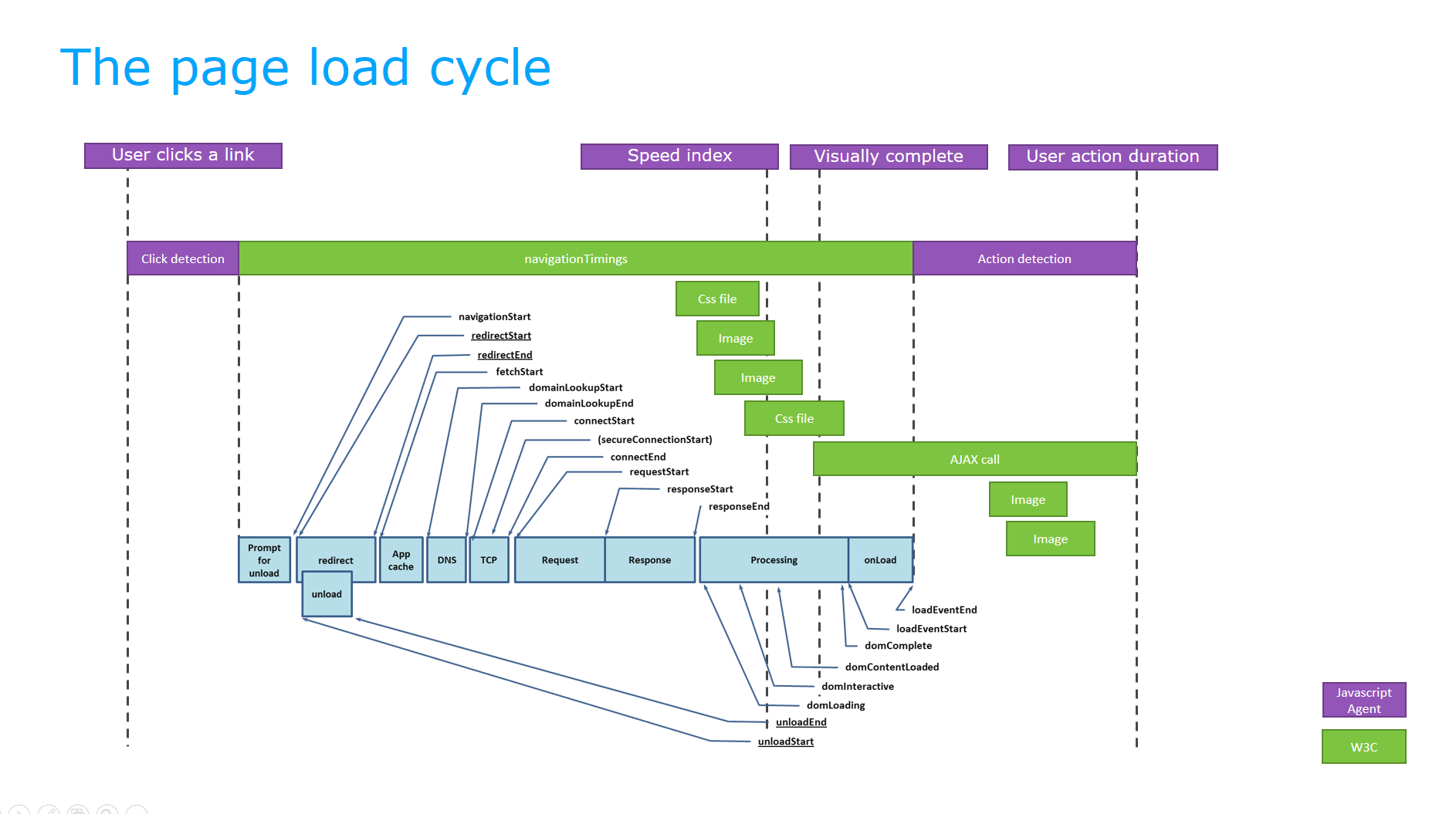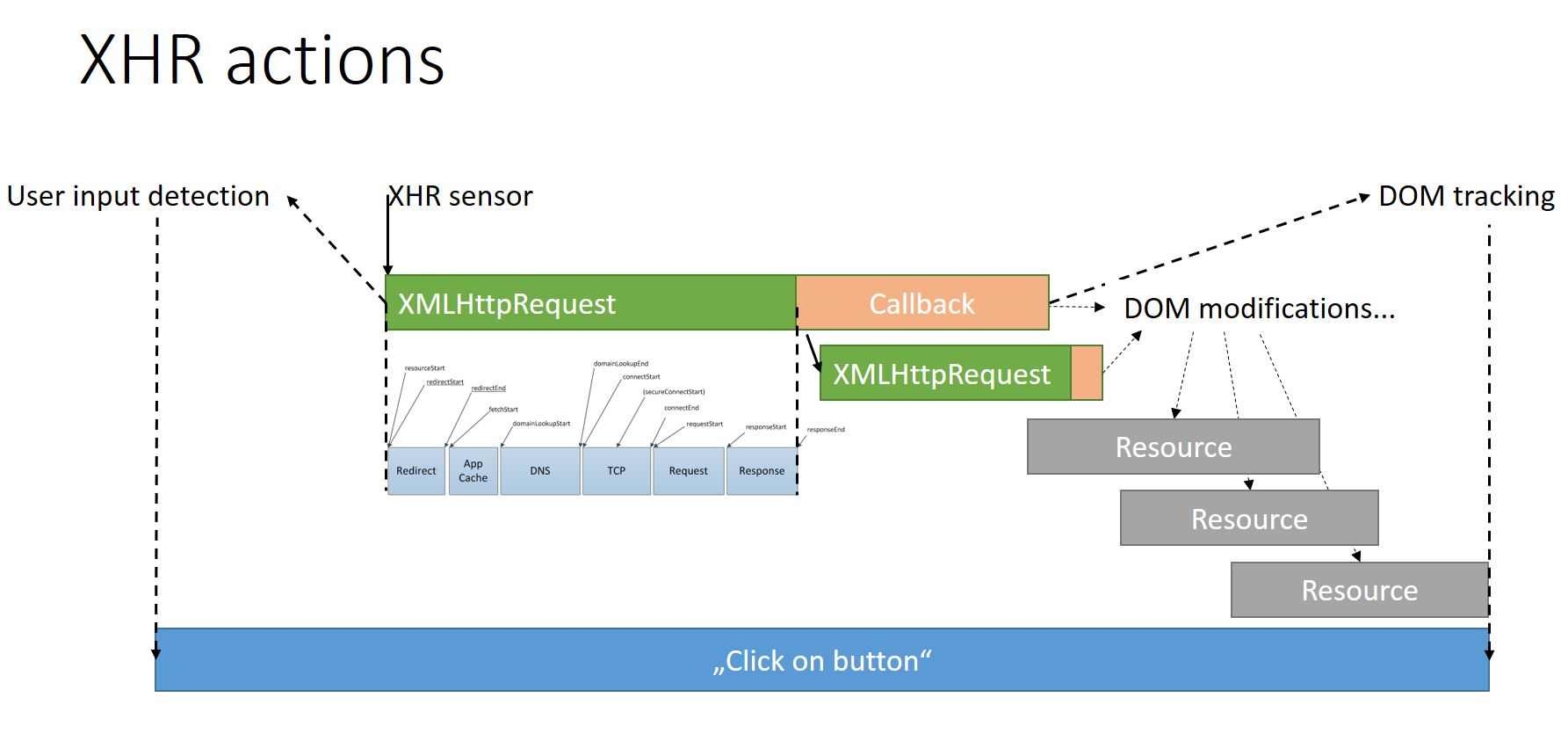User actions
A user action is an interaction with the web browser that involves a call to a web server, which can potentially have multiple nested calls.
User action types
A user action can be a page load, an XHR action or a custom action. The key difference among these action types is the way action duration is calculated and that for each type there are different metrics available.
Page load
A page load is an actual page loading in your browser. If you enter a URL in your browser and press enter, a page load occurs. During a page load, many resources are loaded, including images, HTML, and CSS.
The action duration in this case is the time required for the complete page load. More specifically, the start time of the user action begins with the W3C navigationStart time, if available. If not available, the start time begins when the Real User Monitoring JavaScript code is initialized in the browser. The end time is when the last onload handler has completed its task. The onload handler is an event handler in JavaScript that's used to call the execution of JavaScript after a page, frame, or image has completely loaded. If any XMLHttpRequests (see XHR actions below) are started by an onload handler, the user action ends when the XMLHttpRequest is complete.

Resource timing steps
The following measures are used to chart the duration of specific steps in the page loading process.
| Measure | Description | Definition in terms of W3C specification |
|---|---|---|
| DNS | Time spent or resolving domain names. | window.performance.domainLookupEnd - window.performance.domainLookupStart |
| Connect | Time spent establishing a socket connection from the browser to the web server. | window.performance.connectEnd - window.performance.connectStart |
| SSL | Time spent establishing a secure socket connection from the browser to the web server. | window.performance.connectEnd - window.performance. secureConnectionStart |
| URL Redirection | Time spent following HTTP redirects. | window.performance.redirectEnd - window.performance.redirectStart |
| Request | Time spent waiting for the first byte of the document response. | window.performance.responseStart - window.performance.requestStart |
| Response | Time spent downloading the document response. | window.performance.responseEnd - window.performance.responseStart |
| Total | Time between the response being delivered and the OnLoad event. |
window.performance.loadEventEnd - window.performance.domLoading |
XHR action
Most modern applications, including single page applications, rely on a single page load that downloads the framework and initializes the page. After that, the DOM of the page is changed via JavaScript and all communication with the web server is done via XmlHttpRequest or via fetch().
DESK continuously tracks user interactions with each page. If user interaction leads to XmlHttpRequests or fetch() calls, an XHR action is created. DESK also detects if there are additional XHRs triggered in the callback of the initial XHR and so on. In this case, DESK waits until all requests are finished. By monitoring the DOM, DESK can also identify resources that were added in the callbacks. DESK then waits until those resources have finished downloading before ending the action.

An XHR action starts with the user's click on a control on a web page. All metrics are calculated in relation to this point in time and are based on the initial XHR that triggers the user action.
Fetch API
The Fetch API provides an interface for fetching resources (including across the network). It is similar to XMLHttpRequest, but the API provides a more flexible feature set. The generic definitions of Request, Response and other network request objects in Fetch allow them to be used at any time they are needed, whether it’s for service workers, Cache API, or anything that handles or modifies requests and responses. Fetch also supports the Cross Origin Resource Sharing (CORS).
User actions based on the Fetch API appear in DESK as XHR actions. You can configure DESK to automatically detect and capture Fetch API request information.
Custom user actions
Rather than relying on default user action generation, you may want to fine-tune your Real User Monitoring by adding additional user actions directly into your application’s HTML. This can be useful if our automated user-action generation doesn’t catch specific actions or you want to introduce specific fine-grained timings into your application monitoring. For example, you could measure how long it takes to open a JavaScript-only drop-down menu, or measure the duration time of some JavaScript code. To define custom actions you can use the JavaScript API for Real User Monitoring.
User action naming rules
Many applications allow users to accomplish the same goal through different UI controls. When monitoring such applications, it can be difficult to differentiate between actions that have the same result and goal, but are executed by using different parts of the application UI. Likewise, if the UI of an application is translated into multiple languages, the same application function or control can appear under varying names. With user action naming rules, DESK can detect such subtle variations and intelligently group related user actions (i.e., user actions that achieve the same goal) into logical groups for monitoring.
DESK automatically removes certain common sessionid tokens from user action names (for example, jsessionid for Java containers, the default sessionid for PHP, and CFID and CFTOKEN for ColdFusion). Nonetheless, there are numerous session ID variations that may be present in your environment. If DESK doesn't automatically recognize and remove session IDs from certain user action names you encounter, you'll need to configure custom naming rules for those user actions.
Action name detection
DESK tries to assign meaningful names for actions. To do this, it checks several action properties, such as inner HTML, caption, and hint, of the HTML element that triggers the action. This element can either be a button or an anchor. It also tries to get the caption if there's a more complex HTML structure with multiple nested tags.
Set action name with data-dtname custom attribute
If the standard action name detection doesn't serve your purpose, you can set the data-dtname custom attribute within the HTML tags and use it as a caption. For instance, the following action:
<label for="txtFirstname">Firstname</label> <input data-dtname="Firstname Text Input" type="text" value="firstname" name="firstname" title="Firstname" id="txtFirstname" />
can be assigned the following caption:
click on "Firstname Text input"
Resolving captions for actions
The RUM JavaScript code uses several techniques to decide the name that best fits an action. It starts with the innermost HTML node that is clicked, such as a button, an image tag, or a link, and checks the following in the order of precedence:
- The attribute named
data-dtname. - The nodename such as image, anchor, or input.
It stops when thehtmltag, thebodytag, theheadtag, or thedocumentelement is found. - The innerText/textContent.
If none of these return a reasonable result, the JavaScript code starts applying a recursive algorithm that checks different things depending on the nodeName of the currently checked HTML node. If nothing is found, the parent node is checked.
Key user actions
Most applications, both web and mobile, include user actions (for example, signups, checkouts, and product searches) that are particularly important to the success of your digital business. Such key user actions might take longer to execute than others or they might have the requirement to be of shorter-than-average duration.
For instance, consider that you've set your global Apdex threshold to 3 seconds. While this threshold might be acceptable for the majority of user actions, it might not be acceptable for a sign-up user action. Alternatively, there could be a search action that is quite complex and requires longer than the allotted 5 seconds.
With the key user action feature, you can customize the Apdex thresholds for each of these user actions. You can use this feature to monitor key actions with a dedicated dashboard tile and track historic trends.
Note: DESK allows you to create a maximum of 20 key user actions per application. If a higher limit is required, please contact a DESK ONE product specialist by clicking the chat button in the upper-right corner of the DESK menu bar.
Mark a user action as a key user action
- On the Applications page, select the application, and scroll down to Top 3 user actions.
- Click View full details.
- Under Top 100 user actions, select a user action.
- On the top-right corner of the User action details page, select Mark as key user action. The selected user action will now be displayed under Key user actions on the User action analysis page.
- [Optional] To access a key user action from the dashboard, select an action from the Key user actions list and select Pin to dashboard.
- [Optional] To customize its Apdex rating, on the User action details page of the key user action, select Browse [...] > Edit > Key Performance Metric.